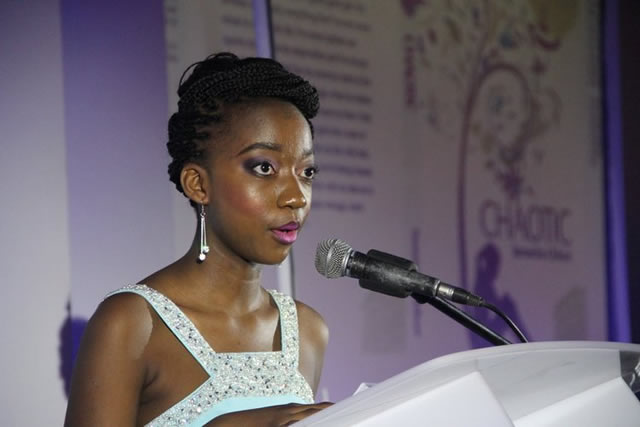Teen writer tackles adolescent dilemma

Beaven Tapureta : Bookshelf
Samantha Chihuri’s National Arts Merit Award winning novel “Chaotic” can best be described as a “teen thriller”. It won the 2016 NAMA award for Outstanding First Creative Published Work. The story, told from the point of view of Amari, a Zimbabwean adolescent whose family has just settled in New York City, “arrests” you into a cinematic world of fast-paced action and vast motley of emotions which teenagers wrestle with in their refusal or acceptance of the intellectual or bodily changes happening to them.
The media all over the world is awash with reports about teens engaging in crime, prostitution, drug abuse, and suicidal behaviour due to depression and peer pressure.
Some teenagers have found family and school to be a horrible place. Parents have lost any control of or completely neglected their teenage children who have gone on the wild side of life.
Although not all of the above-said ills associated with teen-hood are dealt with in “Chaotic”, the book provides a window through which one can see and understand the adolescent psyche.
In her article “Overcoming Fear to Destroy Chaos” published last year in The Herald soon after the launch of “Chaotic”, Samantha gave the story’s theme as “fear” but a discerning reader would notice that there is more than the subject of fear in the novel.
“My book is aimed at young girls who may be battling with a fear of their own, however, through reading about Amari, I hope they see that they have to have inner strength,” wrote Samantha.
In “Chaotic”, 14-year-old Amari is the narrator. Amari, like any other teenager, resents the authority of her father who has been engaged to Candace after Amari’s mother died in a car accident two years back.
Her family (the Zikhali’s) has recently settled in America because her father has been transferred there. What’s more, she is a bit bored — she cannot have a phone of her own!
The character Candace gets you thinking about the stiff, repulsive feelings which stepmothers face from their stepchildren.
As the story begins, Amari and Chris avoid Candace and only pretend to respect her to give their dad an impression of all-is-well. When dad announces Candace is pregnant, Amari and Chris walk out of the house in frustration!
However, at the end of the story Candace, aware of her own position as a parent, appears a strong character, a source of comfort for the family.
Fear could be the theme here but there are sub-thematic side-swipes to it. Amari has an internal fear set in her family, a family which she portrays as a broken unit. With her brother Chris, a teenage also, they are lonely and prefer to have nothing to do with their dad or his fiancée Candace.
This background of a seemingly unstable family unit drives her and her brother Chris into a certain depression, a certain longing to break free (especially on the part of Amari). However, Chris is a little veiled from the main story.
Teenagers want to have fun and adventure. For Amari, there is none until she befriends a peer four-member group (Kendall, Aseem, Leo, and Jas) at her new school. She becomes the fifth member to the group.
Although she feels a new sense of belonging, suddenly the horror begins!
She is exposed to a new fear; fear of the outside, particularly New York being a new strange environment. She is sandwiched between two kinds of fear.
By setting the story in America, the author proved a point that geography is nothing when teenagers are, one way or another, victims of their own whims and need society’s counsel and protection.
The thrill and horror begins when there is a concert in town. The five teens sneak from their homes when everyone else has gone to bed and then meet at a secret place. Yet Leo’s fake tickets cannot get them in. Kendall devices a plan to get in through a window at the back and somehow they land near the backstage.
Amari, in a desperate bid to disguise herself as one of the performers, picks up a costume and put it on. Inside one of its pockets there is a stolen gem — which makes her (and friends) the “quarry” hunted down by two kidnappers!
For Amari, while she thought her dad’s home no longer sufficed, she suddenly realises that America at large, which she hoped would be home sweet home to her new life, has turned into a nightmare!
Trapped with her friends in an unknown room at the outskirts of the city, she meditates, “What was home anyway? Was it in America with Candace, Dad, Chris and our squashed apartment? Or was it back in Zimbabwe with our comfortable house and all my friends at Chisi? Where did I stand?”
One feels the regret that Amari suffers. How she overcomes it to solve her current fix is the subtle force of the story’s plot.
The author’s skilful creation of lively characters, knitting of events and a well sustained suspense confirms that she chose her subject very well and fed into it a power of the imagination that suits her target audience.
Not very often have we come across opportunities to read teen stories written by teenagers in Zimbabwe.
While it is true that the teen writers are visible in school writers clubs and at times lead the production of their school newsletter, not much recognition has been accorded this age-group.
Samantha’s dream, according to her article last year, has always been to have the title “New York Times Best-selling author” attached to her name.
By publishing her debut novel, she said she felt a little closer to accomplishing that dream. Little did she know she will even step a little bit more closer until she was announced NAMA’s award winner on February 13 this year.
“Chaotic”, published by Ess Tee Publications, should be a challenge to other teen writers to overcome their fears and make the first step towards realising their dreams.
Samantha is the daughter of Zimbabwe Republic Police Commissioner-General Dr Augustine Chihuri, who also published his book last year titled “The History of Policing in Zimbabwe”.
Meanwhile, in last week’s instalment Bookshelf had a story about the son of Charles Mungoshi launching his five motivational books. The general idea one get to sense in that Mungoshi article and this Chihuri one is that in families that are driven by the spirit of authorship, the creative inspiration does not necessarily follow a uniform genre.
While Charles Mungoshi Snr is known for his fiction and poetry in both English and Shona, his son is submerged in motivational writing, a kind of “life-inspiring and coaching” writing that may borrow elements and skills of fiction but not to the point of being “fiction”. There are many examples to prove this but that’s a subject for thinking about at some other time.
Dr Chihuri’s book is a valuable non-fiction contribution to the writing of a complete history of our country and his daughter’s “Chaotic”, on the contrary, is fiction.











Comments